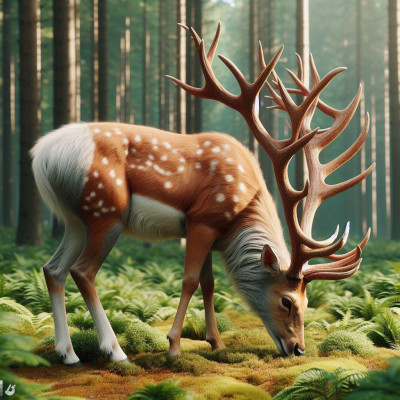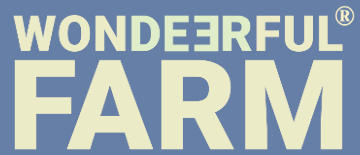Which Deer Species Can Interbreed and Produce Hybrids
» Deer stories » Other Animals » Which Deer Species Can Interbreed and Produce HybridsDifferent species within the same genus of deer can sometimes interbreed and produce offspring. Interbreeding between different deer species is often restricted due to factors like genetic differences, geographical isolation, mating behaviors, and breeding seasons that don’t align. While some hybrids might be fertile, others could be sterile or have reduced fertility, limiting the potential for ongoing interbreeding between species.

AI generated image for illustration purposes only
While researching this topic, we've come across this serious overview of the interbreeding cases, and decided to present the results in this comprehensive table. Please refer to the source article for in-depth explanation of cases.
| Deer Species | Interbreeding Ability | Notes |
|---|---|---|
| Alces alces (Moose/Elk) | × Bos taurus (European Domestic Cattle) | Hybrids reported, but fertility and viability unknown. |
| × Cervus elaphus (Red Deer/Elk/Wapiti) | Hybridization reported, fertility varies among hybrids. | |
| × Equus caballus (Domestic Horse) | Hybrid offspring are rare, and viability/fertility not well documented. | |
| × Odocoileus hemionus (Mule Deer) | Successful hybridization with variable fertility. | |
| Axis axis (Axis Deer) | × Axis porcinus (Hog Deer) | Hybridization observed, fertility and viability of offspring not known. |
| × Cervus duvaucelii (Swamp Deer/Barasingha) | Limited reports of hybridization, fertility status unknown. | |
| × Cervus elaphus (Red Deer/Elk/Wapiti) | Interbreeding possible, fertility and viability not widely documented. | |
| × Cervus nippon (Sika Deer) | Instances of hybridization recorded, fertility may vary. | |
| × Cervus timorensis (Rusa) | Hybridization reported, fertility levels undetermined. | |
| × Cervus unicolor (Sambar) | Hybridization known, but fertility details uncertain. | |
| × Dama dama (Fallow Deer) | Limited hybridization, fertility status unclear. | |
| × Elaphurus davidianus (Père David’s Deer) | Reports of hybrids, fertility rates uncertain. | |
| × Homo sapiens (Human) | No recorded cases of successful hybridization. | |
| × Odocoileus virginianus (White-tailed Deer) | Limited hybridization observed, fertility not well documented. | |
| Axis porcinus (Hog Deer) | × Capreolus capreolus (Western Roe Deer) | Limited reports on hybridization, fertility details scarce. |
| × Dama dama (Fallow Deer) | Occasional hybridization, fertility levels unconfirmed. | |
| Capreolus capreolus (Western Roe Deer) | × Capra hircus (Domestic Goat) | Rare hybridization reported, fertility status unknown. |
| × Capreolus pygargus (Eastern Roe Deer) | Sparse reports of hybridization, fertility details not well-documented. | |
| × Ovis aries (Domestic Sheep) | Instances of hybridization, fertility status not widely known. | |
| × Panolia eldii (Eld's Deer) | Limited reports of hybridization, fertility levels unknown. | |
| Cervus elaphus (Red Deer/Elk/Wapiti) | × Bos taurus (European Domestic Cattle) | Occasional hybrids reported, fertility may vary among individuals. |
| × Cervus nippon (Sika Deer) | Instances of hybridization, fertility can vary among hybrids. | |
| × Cervus unicolor (Sambar) | Hybridization known, fertility levels uncertain. | |
| × Dama dama (Fallow Deer) | Limited hybridization observed, fertility status unclear. | |
| × Elaphurus davidianus (Père David’s Deer) | Reports of hybrids, fertility rates uncertain. | |
| × Equus caballus (Horse) | Limited hybridization recorded, fertility details not well-documented. | |
| × Homo sapiens (Human) | No recorded cases of successful hybridization. | |
| × Odocoileus hemionus (Mule Deer) | Successful hybridization with variable fertility. | |
| × Ovis aries (Domestic Sheep) | Instances of hybridization, fertility status not widely known. | |
| × Panolia eldii (Eld's Deer) | Limited reports of hybridization, fertility levels unknown. | |
| Cervus nippon (Sika Deer) | × Cervus unicolor (Sambar) | Hybridization reported, but fertility details not well-documented. |
| + Ovis aries (Domestic Sheep) (Probable Interbreeding) | Limited cases with probable hybridization reported. | |
| Cervus unicolor (Sambar) | × Dama dama (Fallow Deer) | Limited reports of hybridization, fertility status uncertain. |
| × Odocoileus virginianus (White-tailed Deer) | Limited hybridization observed, fertility details not well-documented. | |
| Dama dama (Fallow Deer) | × Dama mesopotamica (Mesopotamian Fallow Deer) | Hybridization possible, fertility status unknown. |
| × Odocoileus virginianus (White-tailed Deer) | Limited reports of hybridization, fertility status unclear. | |
| Odocoileus columbianus (Black-tailed Deer) | × Odocoileus hemionus (Mule Deer) | Hybridization observed, fertility details not widely documented. |
| Odocoileus hemionus (Mule Deer) | × Capra hircus (Domestic Goat) | Occasional hybridization, fertility and viability vary. |
| × Odocoileus virginianus (White-tailed Deer) | Limited hybridization observed, fertility details not well-documented. | |
| Odocoileus virginianus (White-tailed Deer) | × Bos taurus (European Domestic Cattle) | Limited reports of hybridization, fertility details not well-documented. |
| × Capra hircus (Domestic Goat) | Occasional hybridization, fertility and viability vary. | |
| × Equus caballus (Horse) | Limited reports of hybridization, fertility details not well-documented. | |
| × Ovis aries (Domestic Sheep) | Occasional hybridization, fertility status not widely known. |
Red Deer (Cervus elaphus) and Sika Deer (Cervus nippon): They can interbreed and produce viable offspring called "hybrids."
There's a probable occurrence of interbreeding between Sika and Red Deer species whenever they come into contact. Even isolated Red Deer populations face a risk due to the extensive roaming of Sika stags. In the wild, both Red and Sika populations have the potential to create mixed populations. The interbreeding process leads to changes in weight, possibly resulting in increased similarity in size, which could promote further interbreeding between the two species. [source]
Red Deer (Cervus elaphus) and Elk (Cervus canadensis): In some cases, they have produced hybrids in captive settings, see Ken Drew, 'Deer and deer farming - Breeding', Te Ara - the Encyclopedia of New Zealand
European Fallow Deer (Dama Dama) and Mesopotamian Fallow Deer (Dama Mesopotamica) are different subspecies belong to the same species, so they can hybridise freely and produce fully fertile offspring. So far there's no reports of hybridisation of Fallow Deer with any other species. [Source]
Published 15 December 2023
More «Other Animals» stories
What Animals Eat Walnuts
Several animals have different ways of accessing walnuts, whether by climbing trees, using their strong jaws, or foraging on the ground. Walnuts provide essential nutrients and fats, making them an attractive food source for various wildlife species.
read more...
What Animals Eat Sweetcorn?
Which animals (pests or lifestock) can eat corn. Sweetcorn, with its irresistible sweetness and tender kernels, is not only a favorite among humans but also attracts a variety of animals and pests.
read more...
Make Your Own Deer Feed + a Trough-Style Deer Feeder
Taking care of deer can be rewarding and fun and making your own deer feed is easier than you think. With these tips, you’ll keep your deer well-fed and happy. Enjoy!
read more...
 '
'


